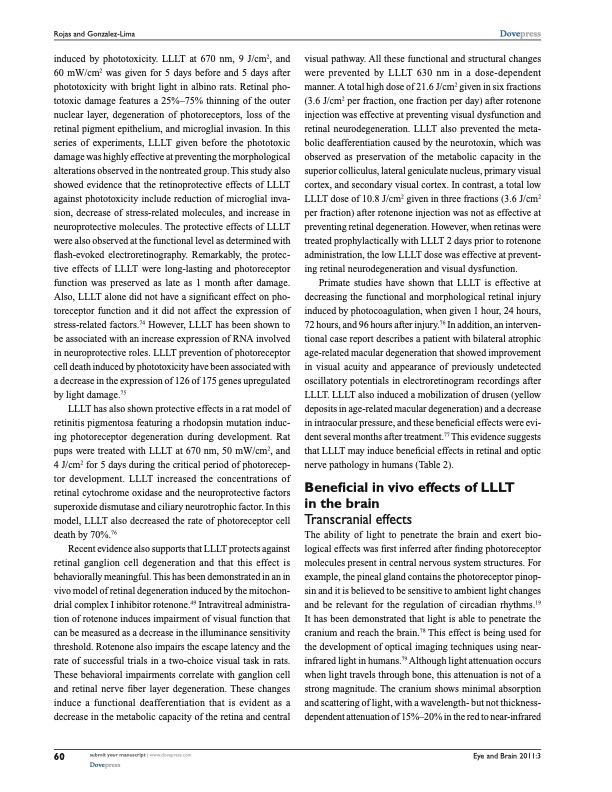
PDF Publication Title:
Text from PDF Page: 012
Rojas and Gonzalez-Lima Dovepress induced by phototoxicity. LLLT at 670 nm, 9 J/cm2, and 60 mW/cm2 was given for 5 days before and 5 days after phototoxicity with bright light in albino rats. Retinal pho- totoxic damage features a 25%–75% thinning of the outer nuclear layer, degeneration of photoreceptors, loss of the retinal pigment epithelium, and microglial invasion. In this series of experiments, LLLT given before the phototoxic damage was highly effective at preventing the morphological alterations observed in the nontreated group. This study also showed evidence that the retinoprotective effects of LLLT against phototoxicity include reduction of microglial inva- sion, decrease of stress-related molecules, and increase in neuroprotective molecules. The protective effects of LLLT were also observed at the functional level as determined with flash-evoked electroretinography. Remarkably, the protec- tive effects of LLLT were long-lasting and photoreceptor function was preserved as late as 1 month after damage. Also, LLLT alone did not have a significant effect on pho- toreceptor function and it did not affect the expression of stress-related factors.74 However, LLLT has been shown to be associated with an increase expression of RNA involved in neuroprotective roles. LLLT prevention of photoreceptor cell death induced by phototoxicity have been associated with a decrease in the expression of 126 of 175 genes upregulated by light damage.75 LLLT has also shown protective effects in a rat model of retinitis pigmentosa featuring a rhodopsin mutation induc- ing photoreceptor degeneration during development. Rat pups were treated with LLLT at 670 nm, 50 mW/cm2, and 4 J/cm2 for 5 days during the critical period of photorecep- tor development. LLLT increased the concentrations of retinal cytochrome oxidase and the neuroprotective factors superoxide dismutase and ciliary neurotrophic factor. In this model, LLLT also decreased the rate of photoreceptor cell death by 70%.76 Recent evidence also supports that LLLT protects against retinal ganglion cell degeneration and that this effect is behaviorally meaningful. This has been demonstrated in an in vivo model of retinal degeneration induced by the mitochon- drial complex I inhibitor rotenone.49 Intravitreal administra- tion of rotenone induces impairment of visual function that can be measured as a decrease in the illuminance sensitivity threshold. Rotenone also impairs the escape latency and the rate of successful trials in a two-choice visual task in rats. These behavioral impairments correlate with ganglion cell and retinal nerve fiber layer degeneration. These changes induce a functional deafferentiation that is evident as a decrease in the metabolic capacity of the retina and central visual pathway. All these functional and structural changes were prevented by LLLT 630 nm in a dose-dependent manner. A total high dose of 21.6 J/cm2 given in six fractions (3.6 J/cm2 per fraction, one fraction per day) after rotenone injection was effective at preventing visual dysfunction and retinal neurodegeneration. LLLT also prevented the meta- bolic deafferentiation caused by the neurotoxin, which was observed as preservation of the metabolic capacity in the superior colliculus, lateral geniculate nucleus, primary visual cortex, and secondary visual cortex. In contrast, a total low LLLT dose of 10.8 J/cm2 given in three fractions (3.6 J/cm2 per fraction) after rotenone injection was not as effective at preventing retinal degeneration. However, when retinas were treated prophylactically with LLLT 2 days prior to rotenone administration, the low LLLT dose was effective at prevent- ing retinal neurodegeneration and visual dysfunction. Primate studies have shown that LLLT is effective at decreasing the functional and morphological retinal injury induced by photocoagulation, when given 1 hour, 24 hours, 72 hours, and 96 hours after injury.76 In addition, an interven- tional case report describes a patient with bilateral atrophic age-related macular degeneration that showed improvement in visual acuity and appearance of previously undetected oscillatory potentials in electroretinogram recordings after LLLT. LLLT also induced a mobilization of drusen (yellow deposits in age-related macular degeneration) and a decrease in intraocular pressure, and these beneficial effects were evi- dent several months after treatment.77 This evidence suggests that LLLT may induce beneficial effects in retinal and optic nerve pathology in humans (Table 2). Beneficial in vivo effects of LLLT in the brain Transcranial effects The ability of light to penetrate the brain and exert bio- logical effects was first inferred after finding photoreceptor molecules present in central nervous system structures. For example, the pineal gland contains the photoreceptor pinop- sin and it is believed to be sensitive to ambient light changes and be relevant for the regulation of circadian rhythms.19 It has been demonstrated that light is able to penetrate the cranium and reach the brain.78 This effect is being used for the development of optical imaging techniques using near- infrared light in humans.79 Although light attenuation occurs when light travels through bone, this attenuation is not of a strong magnitude. The cranium shows minimal absorption and scattering of light, with a wavelength- but not thickness- dependent attenuation of 15%–20% in the red to near-infrared Eye and Brain 2011:3 60 submit your manuscript | www.dovepress.com DovepressPDF Image | Low-level light therapy of the eye and brain

PDF Search Title:
Low-level light therapy of the eye and brainOriginal File Name Searched:
Low-level_light_therapy_of_the_eye_and_brain.pdfDIY PDF Search: Google It | Yahoo | Bing
Cruise Ship Reviews | Luxury Resort | Jet | Yacht | and Travel Tech More Info
Cruising Review Topics and Articles More Info
Software based on Filemaker for the travel industry More Info
The Burgenstock Resort: Reviews on CruisingReview website... More Info
Resort Reviews: World Class resorts... More Info
The Riffelalp Resort: Reviews on CruisingReview website... More Info
| CONTACT TEL: 608-238-6001 Email: greg@cruisingreview.com | RSS | AMP |